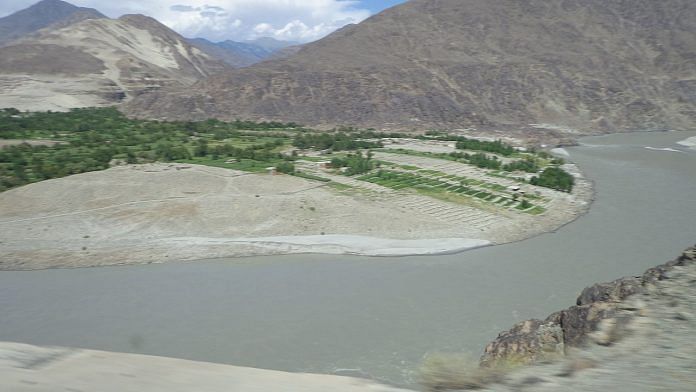New Delhi: The Indus River in Pakistan is in crisis. And two filmmakers have taken it upon themselves to tell the world.
Wajahat Malik’s documentary Expedition Indus 2022 covered an estimated 2,300 kilometres of the entire 3,180 km length of the Indus in Pakistan over 45 days. He filmed the river—the lifeline of Pakistan—on a raft and explained that the project was quite a challenge because no one had rafted the entire length of the river in Pakistan to date, he said speaking to ThePrint. As an adventure filmmaker himself, Malik was excited about the prospect of rafting down the river, but his passion for the subject of the environment and the impact of climate change drove him towards a larger purpose.
His film documents how the river changes and how each time the crew neared a town or a city, they were greeted by a crowd of garbage and plastic blocking their path. “I wanted to see how the river is doing in terms of environment, climate change and form. We didn’t want to bob up and down for the sake of rafting. I am very concerned about water and climate change in this region”, explained Malik.
But his findings were not encouraging. Not wanting to be too alarmist, he explained that besides the main river Indus even its tributaries, which move through different landscapes, carry a lot of garbage. The Kabul River, for example, which empties into the Indus, has many marble factories beside it that are a major cause for concern.
Besides garbage and effluents, climate change has also had a huge impact on the Indus.
Differentiating between snowmelt and glacial melt, where the latter occurs only through rain, Malik said that erratic weather conditions had resulted in lack of glacial melt and, consequently, water scarcity. “Climate change is affecting the river massively. Less rain, freaky weather patterns and dams are not just impacting water availability but even agriculture and quality of the yield.”
Also Read: Baghjan Reels — a stirring documentary on the victims of India’s longest oil well fire
‘Irreversible damage’
While Malik is exploring the issue now through his film, filmmaker Jawad Sharif along with producer Arieb Azhar raised it in 2019 with their documentary Indus Blues.
The film traverses through the musical traditions and cultures along the Indus and illustrates how it changes and expands along its course. However, the film doesn’t shy away from probing the deterioration of nature along the banks.
“Unfortunately, ab Indus, Indus nahi raha. (Indus isn’t Indus anymore) It is full of garbage and trash”, Sharif said to ThePrint. Not just garbage, he explained, because of the multiple dams along the Indus, the flow of the river, along with the communities around it, were seriously affected. For instance, Keti Bandar, a port in the delta region had become a ghost town because of the change in the flow of the river, he explained. The poisonous effluents dumped into the river had also destroyed many old craft traditions such as pottery. The poor quality of soil just wasn’t fit for purpose.
“The damage done in the delta region is irreversible”, said Sharif, when asked if there was hope.
Hope vs expectations for the Indus
Sharif also raised the issue of the Indus in another documentary in 2021 called Natari, which documented the shrinking and sinking Indus Delta and its impact on local communities, drinking water and fishing opportunities.
The story is told through the perspective of a father and a son stranded on an island and their struggles to migrate to a mainland city for a better life.
While Malik still presents a plan of action for the future, saying one needs better water storage, alternative energy sources and smaller dams to stop the deterioration of the Indus, Sharif is less hopeful and reluctantly suggests that having fewer dams would be a step in the right direction.
In April 2022, Sindh chief minister Syed Murad Ali Shah and United Nations’ resident coordinator Julien Harneis launched the Living Indus initiative to repair the damage done to the ecosystem and natural resources in the basin. While in 2021, the Imran Khan government gave his nod to the concept plan for the ‘Ecological Restoration of the Indus Basin’ to combat climate change in the area.
While both these projects are yet to yield results because of the nascent stage they’re in, the Indus River needs immediate support. According to a Dawn report, the river, called the Sindh in Pakistan, is on the ‘verge of running dry’. In such circumstances, the voices of the documentary filmmakers who are going above and beyond their means to tell people of the impending danger of mass draught by 2025, is critical.
(Edited by Srinjoy Dey)



